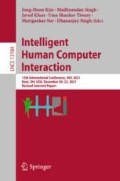Abstract
Examining disability within the context of displacement is a vital area of study. Additionally, further study of assistive technology devices for refugees with disabilities and those in low-resource settings presents the opportunity to dramatically improve the safety and medical welfare of people with disabilities. Mobility Aid project is a pilot study in a Rohingya refugee camp with refugees who have suffered debilitating injuries and need to use crutches to walk. The goal of the project is to improve remote monitoring of disability in the context of displacement. It could be extended to many other environments where people walk with crutches on uneven and muddy terrain.
Access this chapter
Tax calculation will be finalised at checkout
Purchases are for personal use only
References
Women’s Commission for Refugee Women and Children: Disabilities among refugees and conflict-affected populations: resource kit for fieldworkers. International Rescue Committee (2008). https://www.corteidh.or.cr/tablas/25417.pdf
Karanja, M.: Disability in contexts of displacement. Disabil. Stud. Q. 29(4) (2009). https://dsq-sds.org/article/view/969/1177
Human Rights Watch: Burma: Landmines deadly for fleeing Rohingya (2017). https://www.hrw.org/news/2017/09/23/burma-landmines-deadly-fleeing-rohingya
UNHCR: Syrian refugees living with disabilities in camps in Northern Iraq (2014). https://www.refworld.org/pdfid/5492d0204.pdf
ACAPS-NPM: Bangladesh: Considering age and disability in the Rohingya response (2021). https://www.acaps.org/special-report/bangladesh-considering-age-and-disability-rohingya-response?acaps_mode=slow&show_mode=1
Department for International Development: Inclusive access to services for persons with disabilities: Barriers and facilitators report, Jadimura camp, Teknaf (2019). https://data.humdata.org/dataset/inclusive-access-to-services-for-persons-with-disabilities/resource/be02365a-4037-4fa5-8269-6e88736030fd
Brown, S., Vairis, A., Masoumifar, A., Petousis, M.: Enhancing performance of crutches in challenging environments: proposing an alternative design and assessing the expected impact. In: 2019 IEEE Region 10 Conference (2019). https://www.mobilityaid.org/publications
Lipsky, S., Przyjemski, A., Velasquez, M., Gershenson, J.: 3D printing for humanitarian relief: the printer problem. In: 2019 IEEE Global Humanitarian Technology Conference pp. 1–7 (2019). https://doi.org/10.1109/GHTC46095.2019.9033053. https://ieeexplore.ieee.org/document/9033053
Mercy Corps: Lessons learned from 3D printing in the world’s largest Syrian refugee camp (2020). https://www.mercycorps.org/blog/3d-printing-syrian-refugee-camp
Vairis, A., Brown, S., Bess, M., Bae, K.H., Boyack, J.: Assessing stability of crutch users by non-contact methods. Int. J. Environ. Res. Public Health 18(6), 3001 (2021). https://doi.org/10.3390/ijerph18063001
Vairis, A., Boyak, J., Brown, S., Bess, M., Bae, K.: Gait analysis using non-contact method for disabled people in marginalized communities. In: Singh, M., Kang, D.-K., Lee, J.-H., Tiwary, U.S., Singh, D., Chung, W.-Y. (eds.) 12th International Conference, IHCI 2020, Daegu, South Korea, 24–26 November 2020, Proceedings, Part II (2020)
Smith, S.W.: The Scientist and Engineer’s Guide to Digital Signal Processing, vol. 14, p. 626. Technical Publication, San Diego, CA, USA (1997)
Tapiovaara, M.J., Wagner, R.F.: SNR and noise measurements for medical imaging: I. A practical approach based on statistical decision theory. Phys. Med. Biol. 38(1), 71 (1993)
Misaridis, T.X., et al.: Potential of coded excitation in medical ultrasound imaging. Ultrasonics 38(1–8), 183–189 (2000)
Pedersen, M.H., Misaridis, T.X., Jensen, J.A.: Clinical evaluation of chirp-coded excitation in medical ultrasound. Ultrasound Med. Biol. 29(6), 895–905 (2003)
Author information
Authors and Affiliations
Corresponding author
Editor information
Editors and Affiliations
Rights and permissions
Copyright information
© 2022 Springer Nature Switzerland AG
About this paper
Cite this paper
Brown, S., Hussain, F., Vairis, A., Hacker, E., Bess, M. (2022). Remote Monitoring of Disability: A Case Study of Mobility Aid in Rohingya Camp. In: Kim, JH., Singh, M., Khan, J., Tiwary, U.S., Sur, M., Singh, D. (eds) Intelligent Human Computer Interaction. IHCI 2021. Lecture Notes in Computer Science, vol 13184. Springer, Cham. https://doi.org/10.1007/978-3-030-98404-5_10
Download citation
DOI: https://doi.org/10.1007/978-3-030-98404-5_10
Published:
Publisher Name: Springer, Cham
Print ISBN: 978-3-030-98403-8
Online ISBN: 978-3-030-98404-5
eBook Packages: Computer ScienceComputer Science (R0)

